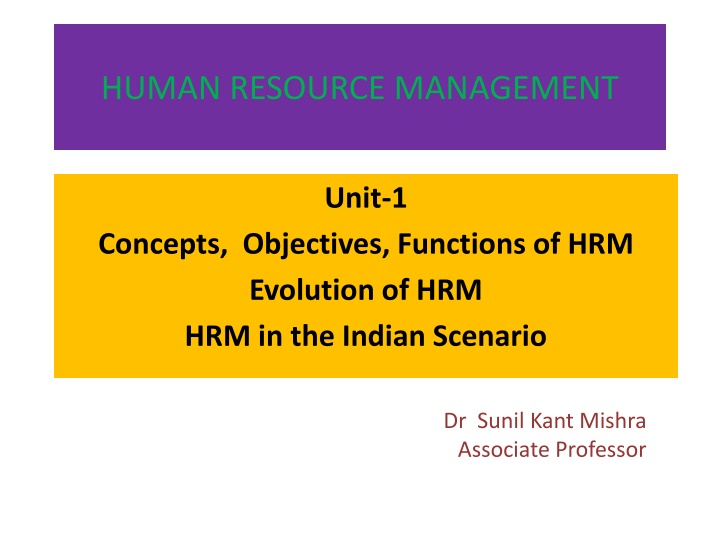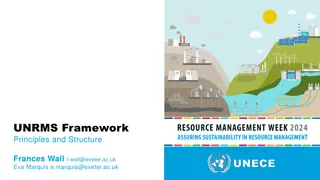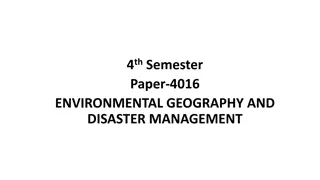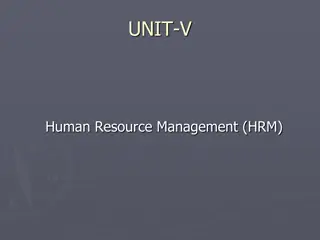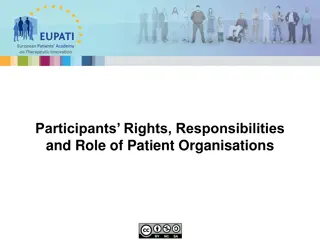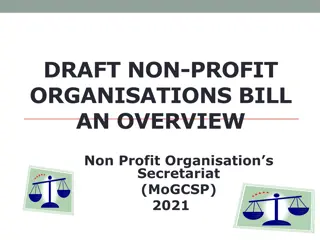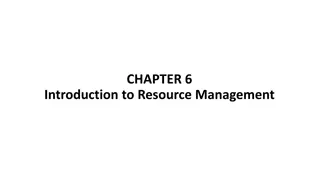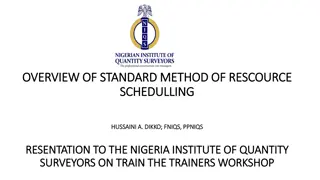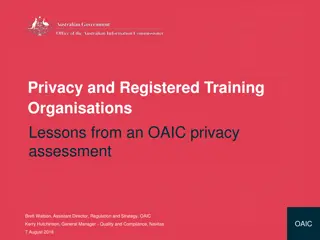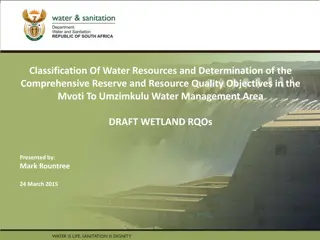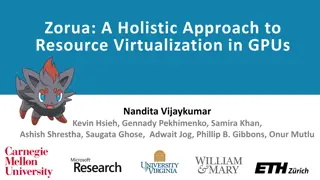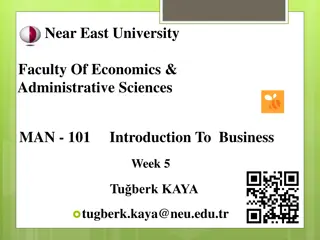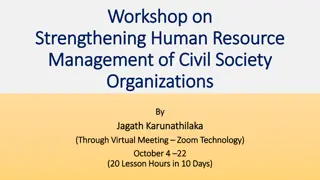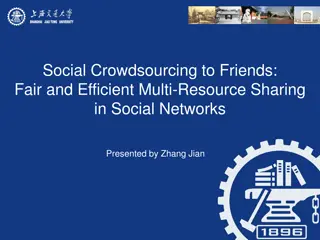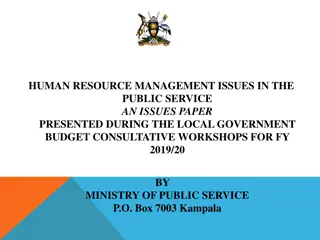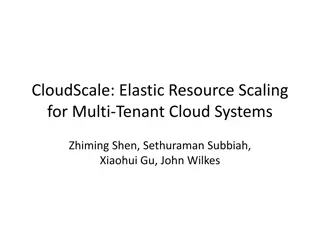Overview of Human Resource Management in Organisations
Human Resource Management (HRM) is crucial for the success of organizations as it involves managing human resources effectively. This includes understanding the unique attributes of human beings, optimizing limited resources, and achieving organizational, individual, and social objectives efficiently and effectively. The evolution of HRM, its functions, and importance in the Indian scenario are highlighted, emphasizing the significance of motivated and skilled human resources. Management is portrayed as the art and science of resource utilization for goal attainment, focusing on optimum utilization and sustainability.
Download Presentation

Please find below an Image/Link to download the presentation.
The content on the website is provided AS IS for your information and personal use only. It may not be sold, licensed, or shared on other websites without obtaining consent from the author.If you encounter any issues during the download, it is possible that the publisher has removed the file from their server.
You are allowed to download the files provided on this website for personal or commercial use, subject to the condition that they are used lawfully. All files are the property of their respective owners.
The content on the website is provided AS IS for your information and personal use only. It may not be sold, licensed, or shared on other websites without obtaining consent from the author.
E N D
Presentation Transcript
HUMAN RESOURCE MANAGEMENT Unit-1 Concepts, Objectives, Functions of HRM Evolution of HRM HRM in the Indian Scenario Dr Sunil Kant Mishra Associate Professor
An organisation is consist of ----- Non-Human Resources Money Material Machines Methods These resources have Capacity to work and their utilization depends upon the ability of Human. Human Resources Human has Capacity to work. It also have Willingness to work which make it different and more complex from Non-Human Resources.
An organisations success depends upon the skills and willpower of its HUMAN resources. Motivated Men will certainly brings happiness to all- Organisation, Individual and Society.
Understanding Human It is a living organism. It has physical attributes made up of Flush & Bones, and Special parts of body required for performing special task. It has Mental ability to observe, gather information, analyze it and come at the conclusion/ decision. It has positive as well negative traits of personality. Creativity, Love, Feelings, happiness, weeping, emotions etc. The Man come at Work Place in totality with Body, Mind and Soul Hatred, Anger,
What is Management Management is an art and science of optimum utilisation of limited resources of an organisation to achieve objectives in efficient and effective way. Optimum Utilisation Utilising the resources keeping in view the capacity of resources, re-building the resources and sustainability. Resources They are limited including the Men at work. Money, Material, Methods, Machines and Men
OBJECTIVES Organisational Individaul Social Organisational objectives can be achieved only when individual and social are kept in mind.
Efficient Way: Doing things Right Efficiency is a quantitative measures. Productivity and profitability should be achieved. Maximum Production at Minimum Cost Effective Way: Doing Right Things It is qualitative measures. Planning and Strategy Lesser Efforts, Lesser Time. Lesser Fatigue Sustainability Approach
Understanding Resource Approach It is Limited It is Valuable It is Precious It is dealt with Security It is insured for uncertainty and future losses.
We have seen that the Non-Human Resources have been treated well and organisations treat these resources valuable, precious and with careful handling. BUT The Human Resources have got attention in the recent years.
Are Human Resources get attention in the organisation ? Men at work were neglected in earlier periods. Slavery system is one of the example of treatment of men at Work. Due to the ill treatment of Men at work, several revolution had taken place in the past in the various corner of the world. Punishment had been adopted as a mean to take work from Labourer. Men at work were not taken as valuable, precious resources and requiring security.
It was the last quarter of previous centaury when men at Work started getting attention for increasing the productivity and profitability. Behavioural Approach/ Human Relation Theory has advocated that productivity can improved further by providing conducive human relation environment in the organisation. Now, organisation recognizes Resources. Successful organisation gives credit of their success to their dedicated Work force. their Human
What is Human Resource Management Prof. M. J. Jucius The field of management which has to do with planning, organizing , directing and controlling various operative functions of procuring , developing , maintaining and utilizing a labour force , such that the: (a) objectives, for which the company is established are attained economically and effectively (b) objectives of all levels of personnel are served to the highest possible degree: and (c) objectives of the community are duly considered and served
As per the definition of Jucious, the HRM is the process of applying managerial functions over its operative functions to achieve organisational objectives. Managerial Functions Operative Functions Objectives Planning Procuring Organising Developing To achieve objectives of Company, all levels of employees community Directing Maintaining and Controlling Utilising
Edward Flippo Personnel Management is the planning organising , directing and controlling of the procurement, development , compensation, integration, maintenance and separation of human resources to the end that individual, organizational and societal objectives are accomplished. Flippo also focuses on the lines of Jucious.
Peter F. Drucker Human Resource Management is the management of workers and work. E.F.L. Breach Human Resource Management is that part of management process which is primarily concerned with the human constituents of an organization.
Conclusion HRM is the process of applying managerial functions over operative functions to manage the men at work to help in achieving organisational objectives.
Concepts / Nature of HRM It is concerned with managing people at work. It is concerned with employees both as an individual as well as a group. It is concerned with helping the employees to develop their potentialities and capacities to the maximum possible extent to help them in achieving optimum satisfaction from jobs. It is inherent in all organisation Small, medium and large Business and social organisation It is of continuous nature. It attempt to get willing cooperation from employees.
Objectives of HRM Societal Objectives Organisational Objectives Functional Objectives Personal Objectives
Societal objectives To be ethically and socially responsible to the needs and challenges of the society while minimising the negative impact of such demands upon the organisation. Organisational objectives To recognise the role of HRM in bringing about organisational effectiveness. The HRM is not an end in itself. It is only a mean.
Functional objectives To maintain the department s contribution at a level appropriate to the organisation s needs. Personal Objectives To assist employees in achieving their personal goals, at least insofar as these goals enhance the individual s contribution to the organisation.
Functions OF HRM Managerial Functions Planning, Organising , Directing, Co-ordinating and Controlling Operative Functions HR Acquisition HR Planning Recruitment Selection Placement Induction HR Development HRD System Training and management development Organisation Development
Appraisal and Compensation Performance appraisal Compensation Incentives and benefits Integration and Maintenance Integration of HR Motivation Communication Empowerment Participation HR Mobility Safety and Health Stress management Industrial Relations IR System, Grievence Redressal, Management of disputes
Supporting Functions HR Information system HR Records HR Research HR Audit system HR Valuation system Advisory Functions Advice to top management Advice to departmental heads
Evaluation of HRM The modern HRM has emerged through many stages namely- Pre-Industrial Revolution Stage The Industrial Revolution stage Scientific Management Stage Trade Unionism Stage Human Relation Stage Human Resource Stage Human Capital / Talent Management stage
Evolution of Concept ofHRM The term HRM is of new origin which has emerged during 1970s. Earlier it was referred to Labour Management, Staff Management, Personnel Management, Personnel Administration etc. The approach to men at work may be broadly categorised as follows: The Commodity Approach The Factor of Production Approach The Paternalistic Approach The Humanitarian Approach The Behavioural Human Resource Approach The Emerging Concepts
Management Stage Concept of HRM Status of HR Pre-Industrial Revolution Stage The Commodity Approach Under Guild System Labour was considered as a commodity to be bought and sold The Industrial Revolution stage The Factor of Production Approach Workers were treated like machine tools . Achieving production target was more important than satisfaction of men Scientific Management Stage Employees were considered a mere operator of machines The Paternalistic Approach Trade Unionism Stage Collective bargaining has became a tool in the hand of labours. Welfare schemes were introduced Human Relation Stage The Humanitarian Approach Employees needs-Physical, social and psychological, got attention Human Resource Stage The Behavioural Human Resource Approach Motivation, dynamics, organizational conflicts. Integration of individual interest got attention Communication, group organisational and Human Capital Management/ Talent The Emerging Concepts Retaining and maintaining talent management .
Evaluation of HRM in India Nowdays, the term HRM is used widely in industry circles. The welfare of workers in the managementof business enterprises has been in existence since ages.
HRM in Ancient India Kautilya s Arthshastra states that there existed a sound management of resources as early as the 4th Centaury BC. The government then took an active interest in the operation of public and private enterprises and provided systematic procedures for regulating employer-employee relationship. base for systematic
HRM outside India: Early Phase Period Particulars Principles of HRM 1800 BC Babylonion Code of Hamburabi Minimum and incentive wage plans 1650 BC Chinese Principle of division of labour 1250 BC Moses Span of management and related concepts 400 BC Chaldeans Incentive wage plans 400 BC Chinese Labour turnover
HRM in India in 20th Century Period Development status Outlook Emphasis Status 1920-1930 Beginning Pragmatism of capitalists Statutory, welfare, parentalism Clerical 1940-1960 Struggling for recognition Technical, legalistic Introduction of techniques Administrativ e 1970-1980 Achieving sophistication Professional Legalistic Impersonal Regulatory, confirming, imposition of standards on other functions Managerial 1990s------ Promising Philosophical Human values Productivity through People Executive
Important milestones Mile stone of HRM Key recommendation Year 1920 State intervention To protect the interest of workers because of the difficult conditions which followed the Ist World War 1931 Royal Commission Appointment of Labour-Welfare Officer 1948 Factories Act Appointment of Welfare Officer made compulsory in factories employing 500 or more workers 1950s Establishment of National Institute of labour Management, Mumbai and Indian Institute of Personnel Management, KolKota 1960s Personnel function expanded beyond the welfare aspects-focus toward professionalism, IR, Personnel administration 1970s Welfare aspect shifted toward development aspect of employees. HRD, HR New challenges, new technologies 1980s Two professional bodies IIPM and NILM merged in 1980 to form new body National Institute of Personnel Management 1990s Emphasis shifted to Human values and productivity through people 21st Century 21st Century have witnessed changing demographics shortage of skilled and talented Human resource. Acquire high place in Corporate planning and strategy.
Thank you continue learning
